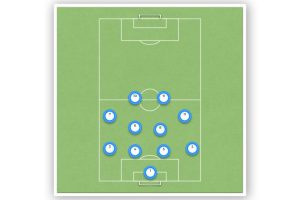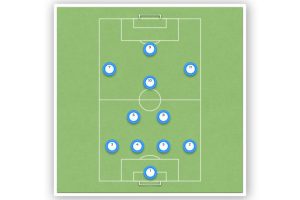Mastering the 4-4-2 Formation: Tips and Strategies for Effective Team Play
Coaches and players are always looking for ways to improve their team’s performance on the field. One of the ways to achieve this is by effectively using the 4-4-2 formation. The 4-4-2 formation is a classic formation in soccer that has been used by many successful teams around the world.
The 4-4-2 formation is a balanced formation that consists of four defenders, four midfielders, and two forwards. The midfielders are responsible for both attacking and defending, while the forwards focus on scoring goals. The defenders are tasked with keeping the opposing team from scoring.
Using the 4-4-2 formation requires a good understanding of the roles and responsibilities of each player on the field. It is important to have a clear plan and strategy in place to effectively utilize this formation. In the following sections, we will explore the key elements of the 4-4-2 formation and provide tips on how to use it effectively in your team.
Understanding the 4-4-2 Formation
Basic Principles of the 4-4-2 Formation
The 4-4-2 formation is a classic formation that has been used by many successful teams. It consists of four defenders, four midfielders, and two forwards. The basic principles of the 4-4-2 formation are to maintain a strong defense while also having enough players in attack to create scoring opportunities. The formation is also flexible and can be adjusted to suit different game situations.
One of the key features of the 4-4-2 formation is its symmetry. The four defenders are split into two center-backs and two full-backs, while the four midfielders are split into two central midfielders and two wide midfielders. The two forwards are usually a striker and a support striker.
The 4-4-2 formation is a balanced formation that allows teams to attack and defend effectively. It is also a formation that is easy to understand and execute, making it a popular choice for many teams.
Roles and Responsibilities of Each Position
Each position in the 4-4-2 formation has specific roles and responsibilities. Understanding these roles is essential for players to perform their duties effectively.
| Position | Role |
|---|---|
| Goalkeeper | Protect the goal and organize the defense |
| Center-backs | Defend the central area of the pitch and provide cover for full-backs |
| Full-backs | Provide width in attack and defend the flanks |
| Central midfielders | Control the center of the pitch, support both defense and attack, and distribute the ball |
| Wide midfielders | Provide width in attack, defend the flanks, and support the strikers and full-backs |
| Forwards | Score goals, hold up the ball, and create scoring opportunities for themselves and their teammates |
The success of the 4-4-2 formation depends on the players understanding and executing their roles and responsibilities effectively. The center-backs and central midfielders are the backbone of the team, providing a solid defense and a strong midfield presence. The full-backs and wide midfielders are responsible for providing width in attack and defending the flanks. The forwards are the goal scorers and the creative force in attack.
Overall, the 4-4-2 formation is a versatile and effective formation that can be used by teams of all levels. Understanding the basic principles and roles of each position is essential for success with this formation.
Advantages of the 4-4-2 Formation
The 4-4-2 formation is a classic formation in football that has been used by many successful teams throughout history. It is a versatile formation that can be adapted to suit different styles of play and can provide many advantages to teams that use it effectively.
Solid Defensive Structure
One of the key advantages of the 4-4-2 formation is its solid defensive structure. With four defenders and two defensive midfielders, the team can create a strong defensive block that is difficult for the opposition to break down. This can be particularly effective against teams that rely on a single striker, as the defenders can focus their attention on marking that player and limiting their opportunities to score.
The 4-4-2 formation also allows the team to quickly transition from defense to attack. When the team regains possession of the ball, the two strikers can quickly move forward and create scoring opportunities, while the rest of the team provides support from behind.
Effective Counter-Attacking Opportunities
Another advantage of the 4-4-2 formation is its ability to create effective counter-attacking opportunities. With two strikers and two wingers, the team can quickly move the ball forward and create scoring chances on the break. This can be particularly effective against teams that play with a high defensive line, as the strikers can exploit the space behind the defenders and create one-on-one opportunities with the goalkeeper.
When using the 4-4-2 formation, it is important for the team to have quick and skillful players in the attacking positions. The wingers should be able to dribble past defenders and deliver accurate crosses, while the strikers should be able to finish with precision and power.
Flexibility in Midfield
The 4-4-2 formation also provides flexibility in midfield, allowing the team to adapt to different situations and opponents. The two central midfielders can play a variety of roles, including defensive, attacking, and box-to-box, depending on the needs of the team. This can provide the team with a strong midfield presence that can control the game and create scoring opportunities.
When using the 4-4-2 formation, it is important for the midfielders to have good communication and understanding of their roles. They should be able to work together to create passing lanes and support the attack, while also providing cover for the defense when needed.
| Advantages of the 4-4-2 Formation |
|---|
| Solid defensive structure |
| Effective counter-attacking opportunities |
| Flexibility in midfield |
Disadvantages of the 4-4-2 Formation
Lack of Numbers in Midfield
The 4-4-2 formation has a well-balanced midfield, but it lacks the numbers that other formations provide. This can make it difficult to maintain possession and control the midfield. In more complex formations, there are usually more options available to the player on the ball due to the width, depth, and angles that other formations provide. The 4-4-2 formation can be vulnerable to being overrun in midfield by teams that play with more players in that area of the pitch.
Teams that play with a 4-4-2 formation may find themselves unable to counter attacking football effectively. This is because they have fewer players in midfield to win the ball back and start a counter-attack. The lack of numbers in midfield can also make it difficult for teams to maintain control over a game, especially when it comes to dominating possession. Often, they will have to surrender the ball to the opposition for large parts of the game, acting with discipline and waiting for the right moment to pounce.
Difficulty in Building Play from the Back
Another disadvantage of the 4-4-2 formation is the difficulty in building play from the back. The formation relies heavily on the long ball, which can be predictable and ineffective against teams that are well-organized defensively. The central defenders work closely with the fullbacks and midfielders to coordinate the defense. For instance, they’ll call the midfielders to drop back when the fullbacks have bombed forward. However, this can lead to a lack of passing options and angles, making it difficult to build play from the back.
Teams that play with a 4-4-2 formation may also struggle to create chances from wide areas. This is because the formation does not have any natural wingers. Instead, the wide midfielders are expected to provide width, but they often drift inside to support the central midfielders and strikers. This can make it difficult to stretch the opposition defense and create space for attacking runs from the fullbacks.
| Disadvantages of 4-4-2 Formation | |
|---|---|
| Lack of numbers in midfield | Difficulty in building play from the back |
| Can be vulnerable to being overrun in midfield | Relies heavily on the long ball |
| Difficult to maintain control over a game | Struggles to create chances from wide areas |
Tips for Implementing the 4-4-2 Formation
Selecting the Right Players for Each Position
One of the most important things to consider when implementing the 4-4-2 formation is selecting the right players for each position. The formation relies heavily on having a strong and balanced midfield, so it’s crucial to choose players who can play both defensively and offensively. The central midfielders should be able to cover a lot of ground, have good passing skills, and be able to read the game well. The wingers should be fast, have good dribbling skills, and be able to cross the ball into the box. The full-backs should be strong defensively and able to overlap with the wingers when attacking.
It’s also important to choose the right players for the forward positions. The two strikers should have a good understanding of each other’s movements and be able to play off each other. One striker should be a strong target man who can hold up the ball and bring others into play, while the other should be a quick and agile player who can run in behind the opposition defence.
Training and Practice Sessions
Implementing the 4-4-2 formation requires a lot of practice and training sessions. It’s important to work on the team’s defensive shape and positioning, as well as their ability to counter-attack quickly. The midfielders should work on their passing and movement off the ball, while the strikers should practice their combination play and finishing.
Set up small-sided games in training that replicate game situations. This will allow players to get used to the formation and understand their roles and responsibilities. It’s also important to work on set-piece routines, as the 4-4-2 formation is well-suited to attacking set-pieces.
Adjusting the Formation to Suit Your Team’s Needs
While the 4-4-2 formation is a solid and well-balanced formation, it’s important to adjust it to suit your team’s needs. For example, if your team is playing against a team with a strong midfield, you may want to drop one of the strikers back into midfield to provide extra cover. Alternatively, if your team is playing against a weaker opposition, you may want to play with more attacking wingers to exploit their defensive weaknesses.
It’s also important to be flexible during games and make changes if things aren’t working. For example, if your team is struggling to create chances, you may want to switch to a more attacking formation like a 4-3-3.
| Selecting the Right Players for Each Position | Training and Practice Sessions | Adjusting the Formation to Suit Your Team’s Needs |
|---|---|---|
| Choose midfielders who can play both defensively and offensively | Work on the team’s defensive shape and positioning | Adjust the formation to suit the opposition’s strengths and weaknesses |
| Wingers should be fast and have good dribbling skills | Practice set-piece routines | Be flexible during games and make changes if necessary |
| Full-backs should be strong defensively and able to overlap with the wingers | Practice combination play and finishing | |
| Strikers should have a good understanding of each other’s movements |





